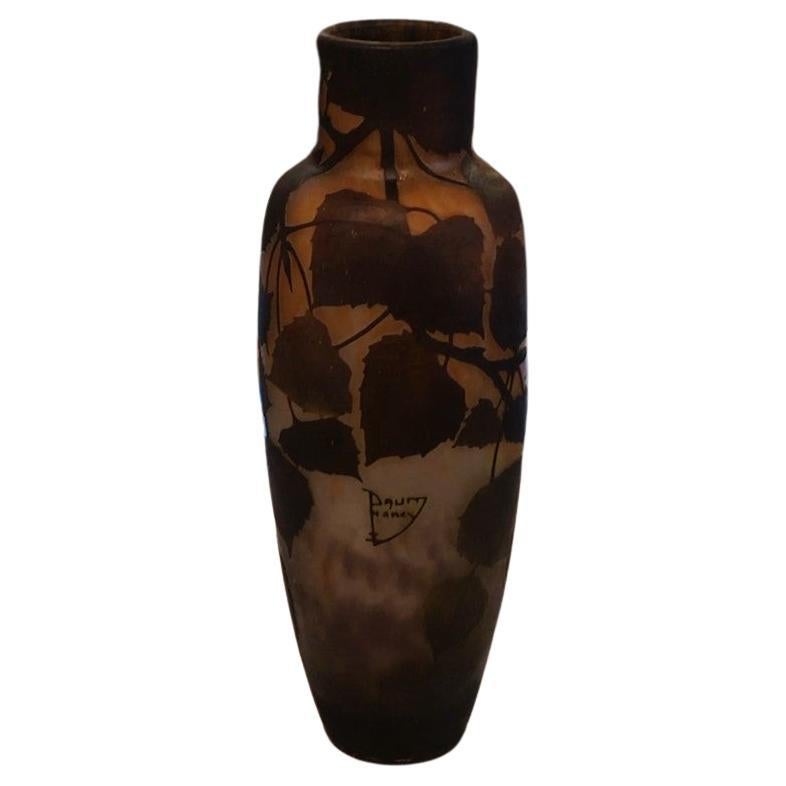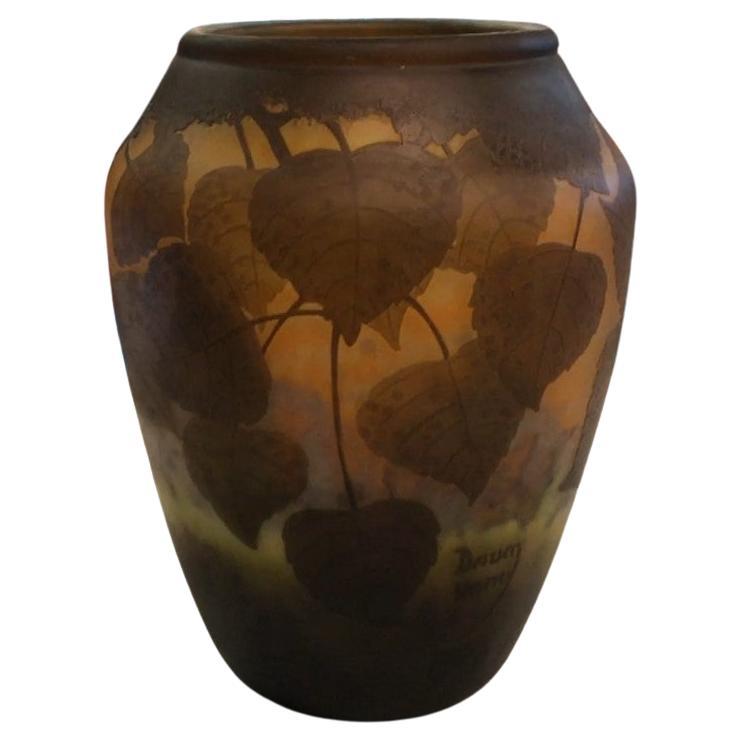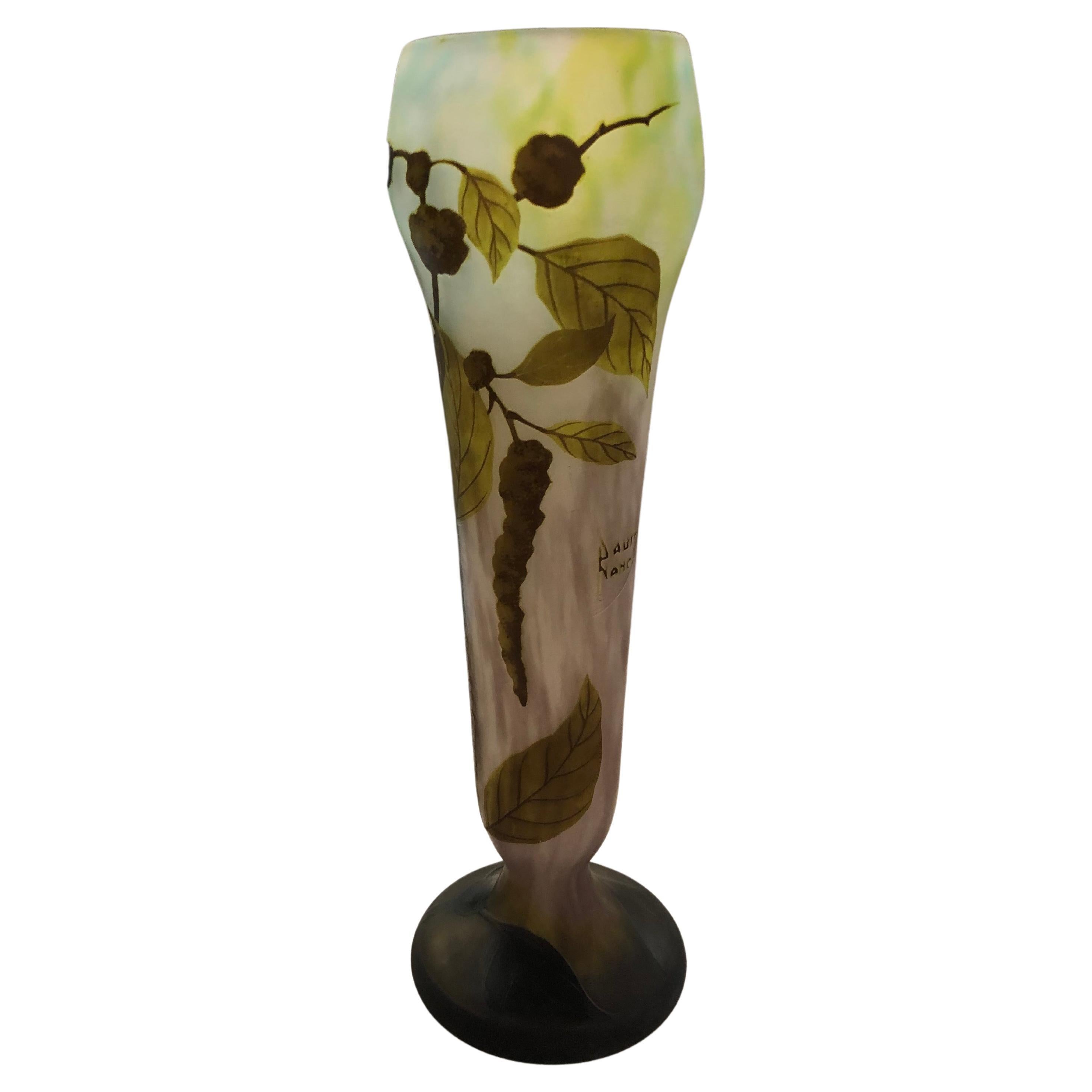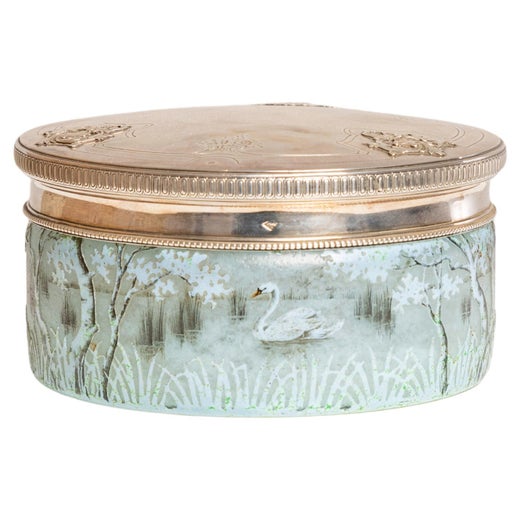Vase Daum Nancy , France, Style: Jugendstil, Art Nouveau, Liberty, 1910
About the Item
- Creator:Daum (Designer)
- Dimensions:Height: 42 in (106.68 cm)Diameter: 16 in (40.64 cm)
- Style:Art Deco (Of the Period)
- Materials and Techniques:
- Place of Origin:
- Period:1910-1919
- Date of Manufacture:1910
- Condition:Wear consistent with age and use.
- Seller Location:Ciudad Autónoma Buenos Aires, AR
- Reference Number:
Daum
For collectors, Daum is a name in the first rank of the French makers of art glass, along with those of Émile Gallé and René Lalique. Led in its early decades by the brothers Auguste (1853–1909) and Antonin Daum (1864–1931), the company, based in the city of Nancy, established its reputation in the Art Nouveau period, and later successfully adopted the Art Deco style.
In 1878, lawyer Jean Daum took over the ownership of a glassworks as payment for a debt and installed his sons as proprietors. Initially, Daum made glass for everyday purposes such as windows, watches and tableware, but the success that Gallé enjoyed at the 1889 Universal Exposition in Paris — the international showcase for which the Eiffel Tower was built — inspired the Daum brothers to begin making art-glass pieces. They produced popular works of cameo glass, a decorative technique in which an outer layer of glass is acid-etched or carved off to reveal the layer below, but Daum became best known for vessels and sculptures in pâte de verre — a painstaking method in which finely ground colored glass is mixed with a binder, placed in a mold and then fired in a kiln.
Though early Daum glass was never signed by individual artists, the firm employed some of the masters of the naturalistic, asymmetrical Art Nouveau style, including Jacques Grüber, Henri Bergé and Amalric Walter (whose first name is frequently misspelled). Daum also collaborated with furniture and metalware designer Louis Majorelle, who created wrought-iron and brass mounts for vases and table lamps. In the 1960s, Daum commissioned fine artists, most notably Salvador Dalí and sculptor César Baldaccini, to design glass pieces. As you see from the works offered on 1stDibs, Daum has been home to an astonishingly rich roster of creative spirits and is today a state-owned enterprise making pâte de verre figurines.
- ShippingRetrieving quote...Ships From: Ciudad Autónoma Buenos Aires, Argentina
- Return PolicyThis item cannot be returned.
- Vase Daum Nancy , France, Style: Jugendstil, Art Nouveau, Liberty, 1910By DaumLocated in Ciudad Autónoma Buenos Aires, CDaum Nancy Daum is the name of a factory established in 1875 in the city of Nancy, France. When the notary Jean Daum became the owner of an industrial furnace, that of Nancy Glass, ...Category
Vintage 1910s French Art Deco Glass
MaterialsGlass
- Daum Nancy, France, Style: Jugendstil, Art Nouveau, Liberty, 1910By DaumLocated in Ciudad Autónoma Buenos Aires, CDaum Nancy Daum is the name of a factory established in 1875 in the city of Nancy, France. When the notary Jean Daum became the owner of an industrial furnace, that of Nancy Glass, ...Category
Vintage 1910s French Art Deco Glass
MaterialsGlass
- Amaizing Vase, Daum Nancy, France, Style: Jugendstil, Art Nouveau, Liberty, 1910By DaumLocated in Ciudad Autónoma Buenos Aires, CDaum Nancy Daum is the name of a factory established in 1875 in the city of Nancy, France. When the notary Jean Daum became the owner of an industrial furnace, that of Nancy Glass, ...Category
Vintage 1910s French Art Deco Glass
MaterialsGlass
- Vase, Daum Nancy France, Style: Jugendstil, Art Nouveau, LibertyBy DaumLocated in Ciudad Autónoma Buenos Aires, CDaum Nancy Daum is the name of a factory established in 1875 in the city of Nancy, France. When the notary Jean Daum became the owner of an industrial furnace, that of Nancy Glass, ...Category
Vintage 1920s French Art Deco Glass
MaterialsGlass
- Vase, Sign: Daum Nancy France, Style: Jugendstil, Art Nouveau, Liberty, 1910By DaumLocated in Ciudad Autónoma Buenos Aires, CSign: Daum Nancy France Daum is the name of a factory established in 1875 in the city of Nancy, France. When the notary Jean Daum became the owner of...Category
Vintage 1910s French Art Nouveau Glass
MaterialsGlass
- Vase, Sign: Daum Nancy , 1910, Style: Jugendstil, Art Nouveau, LibertyBy DaumLocated in Ciudad Autónoma Buenos Aires, CSign: Daum Nancy Daum is the name of a factory established in 1875 in the city of Nancy, France. When the notary Jean Daum became the owner of an industrial furnace, that of Nancy G...Category
Vintage 1910s French Art Nouveau Glass
MaterialsGlass
- Large Art Nouveau Cameo Vase, Solanum Dulcamara Decor, Daum Nancy, France, 1910By DaumLocated in Vienna, ATLarge baluster vase on a separate stand, bulbous walls widening at the top towards the opening, colorless glass with flaky white and yellowish, yellow-orange, in the stand area with dark brown-violet powder inclusions, with etched and painted in colored enamel Bittersweet nightshade (Solanum dulcamara) decor, satin surface in the background, base and bottom smoothly polished and covered with green enamel, relief signature 'DAUM NANCY' with a Cross of Lorraine on the wall between the plants. Technique: Handmade cameo glass Glass overlaid with several layers, with high-cut worked out motifs. Since the middle of the 19th century, the design has also been done by etching. Cameo glass vessels...Category
Vintage 1910s French Art Nouveau Glass
MaterialsGlass
- Daum Nancy Art Nouveau Cameo Vase with Alumroot Decor, France, circa 1910By DaumLocated in Vienna, ATSmall baluster vase, flush round stand, bulbous body with attached funnel-shaped neck, colorless glass with color powder enamels in white, yellow and brown, overlay in red, green and...Category
Vintage 1910s French Art Nouveau Glass
MaterialsGlass
- Art Nouveau Cameo Vase With Daphne Decor, Daum Nancy, France, ca 1910By DaumLocated in Vienna, ATBeaker-shaped vase on a stepped, conical base, widening upwards to a square mouth rim, colorless glass with flaky white, yellow and blue, in the base area with green colored powder inclusions, with etched and painted in colored enamel Daphne decor, satin surface in the background, floor smooth polished, relief signature 'DAUM NANCY' with cross of Lorraine on the wall between the plants. Technique: Handmade cameo glass Glass overlaid with several layers, with high-cut worked out motifs. Since the middle of the 19th century, the design has also been done by etching. Cameo glass vessels...Category
Vintage 1910s French Art Nouveau Glass
MaterialsGlass
- Art Nouveau Vase with Delicate Flower Branches Decor, Daum Nancy, France, c 1910By DaumLocated in Vienna, ATSlender baluster vase, colorless glass with white and yellow, in the lower area with meadow green powder inclusions, arched, flush base with green-turquoise color inclusions, as well...Category
Vintage 1910s French Art Nouveau Glass
MaterialsGlass
- Large Art Nouveau Cameo Vase with Daphne Decor, Daum Nancy, France, 1910/15By DaumLocated in Vienna, ATLarge long neck vase vase with a bulbous base and a round stand and a neck that tapers towards the top, colorless glass with flaky white and yellow, in the stand area with light gree...Category
Vintage 1910s French Art Nouveau Glass
MaterialsGlass
- Large Art Nouveau Cameo Vase with Rosehip Decor, Daum Nancy, France, circa 1910By DaumLocated in Vienna, ATLarge baluster vase on a separate foot, colorless glass with flaky white, yellow-green and brown colored powder inclusions, overlay in yellow, orange-red, green and brown, rosehip decoration etched in several stages, satin-finished surface in the background and on the inside, large cameo signature 'Daum Nancy' with Cross of Lorraine midway between the plants. Technique: Handmade cameo glass Glass overlaid with several layers, with high-cut worked out motifs. Since the middle of the 19th century, the design has also been done by etching. Cameo glass vessels...Category
Vintage 1910s French Art Nouveau Glass
MaterialsGlass






